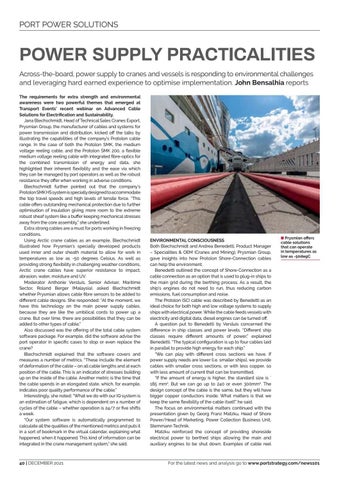PORT POWER SOLUTIONS
POWER SUPPLY PRACTICALITIES Across-the-board, power supply to cranes and vessels is responding to environmental challenges and leveraging hard earned experience to optimise implementation. John Bensalhia reports The requirements for extra strength and environmental awareness were two powerful themes that emerged at Transport Events’ recent webinar on Advanced Cable Solutions for Electrification and Sustainability. Jana Blechschmidt, Head of Technical Sales Cranes Export, Prysmian Group, the manufacturer of cables and systems for power transmission and distribution, kicked off the talks by illustrating the capabilities of the company’s Protolon cable range. In the case of both the Protolon SMK, the medium voltage reeling cable, and the Protolon SMK 200, a flexible medium voltage reeling cable with integrated fibre-optics for the combined transmission of energy and data, she highlighted their inherent flexibility and the ease via which they can be managed by port operators as well as the robust resistance they offer when working in adverse conditions. Blechschmidt further pointed out that the company’s Protolon SMK HS system is specially designed to accommodate the top travel speeds and high levels of tensile force. “This cable offers outstanding mechanical protection due to further optimisation of insulation giving more room to the extreme robust sheaf system like a buffer keeping mechanical stresses away from the core assembly,” she underlined. Extra strong cables are a must for ports working in freezing conditions. Using Arctic crane cables as an example, Blechschmidt illustrated how Prysmian’s specially developed products used inner and outer sheath material to allow for work in temperatures as low as -50 degrees Celsius. As well as providing strong flexibility in challenging weather conditions, Arctic crane cables have superior resistance to impact, abrasion, water, moisture and UV. Moderator Anthonie Versluis, Senior Adviser, Maritime Sector, Roland Berger (Malaysia), asked Blechschmidt whether Prysmian allows cable fibre sensors to be added to different cable designs. She responded: “At the moment, we have this technology on the main power supply cables, because they are like the umbilical cords to power up a crane. But over time, there are possibilities that they can be added to other types of cable.” Also discussed was the offering of the total cable system software package. For example, did the software advise the port operator in specific cases to stop or even replace the crane? Blechschmidt explained that the software covers and measures a number of metrics. “These include the element of deformation of the cable – on all cable lengths and at each position of the cable. This is an indicator of stresses building up on the inside of the cable. Another metric is the time that the cable spends in an elongated state, which, for example, indicates poor quality performance of the cable.” Interestingly, she noted: “What we do with our IQ system is an estimation of fatigue, which is dependent on a number of cycles of the cable – whether operation is 24/7 or five shifts a week. “Our system software is automatically programmed to calculate all the qualities of the mentioned metrics and puts it in a sort of bookmark in the virtual calendar, explaining what happened, when it happened. This kind of information can be integrated in the crane management system,” she said.
40 | DECEMBER 2021
ENVIRONMENTAL CONSCIOUSNESS Both Blechschmidt and Andrea Benedetti, Product Manager – Specialities & OEM (Cranes and Mining), Prysmian Group, gave insights into how Protolon Shore-Connection cables can help the environment. Benedetti outlined the concept of Shore-Connection as a cable connection as an option that is used to plug-in ships to the main grid during the berthing process. As a result, the ship’s engines do not need to run, thus reducing carbon emissions, fuel consumption and noise. The Protolon (SC) cable was described by Benedetti as an ideal choice for both high and low voltage systems to supply ships with electrical power. While the cable feeds vessels with electricity and digital data, diesel engines can be turned off. A question put to Benedetti by Versluis concerned the difference in ship classes and power levels. “Different ship classes require different amounts of power,” explained Benedetti. “The typical configuration is up to four cables laid in parallel to provide high energy for each ship.” “We can play with different cross sections we have. If power supply needs are lower (i.e. smaller ships), we provide cables with smaller cross sections, or with less copper, so with less amount of current that can be transmitted. “If the amount of energy is higher, the standard size is ` 185 mm2. But we can go up to 240 or even 300mm2. The design concept of the cable is the same, but they will have bigger copper conductors inside. What matters is that we keep the same flexibility of the cable itself,” he said. The focus on environmental matters continued with the presentation given by Georg Franz Matzku, Head of Shore Power/Head of Marketing, Power Collection Business Unit, Stemmann Technik. Matzku reinforced the concept of providing shoreside electrical power to berthed ships allowing the main and auxiliary engines to be shut down. Examples of cable reel
8 Prysmian offers cable solutions that can operate in temperatures as low as -50degC
For the latest news and analysis go to www.portstrategy.com/news101














